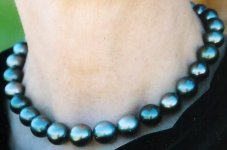Cyril Roger Brossard
Well-known member
- Joined
- Aug 30, 2012
- Messages
- 408
We?ve been led to believe that a grain of sand in an oyster is what makes a pearl. Sorry to burst your bubble, but that simply isn?t true. It?s a myth. Pearl lore or marketing or both perpetuate that untruth. Pearls are not made from grains of sand.

Let me be clear. Before pearls were cultured, lucky fishermen might have encountered a few natural pearls in their lifetimes. Not all oysters make pearls, and the ones that do make them very infrequently. The odds for the production of a natural pearl are about one in 10,000 oysters, at best.
The ordinary person encounters an oyster much less frequently than a fisherman. For example, finding pearls at a restaurant in your oysters-on-a-half-shell is a low yield process. Put those two things together?rare natural occurrence and infrequent encounter?and you have a better chance of winning the lottery than finding a pearl.
Furthering the myth of the natural pearl is the misconception about sand in the oyster. Since oysters live on the bottoms of saltwater seas, it is reasonable to assume that grains of sand might get stuck inside the shell. And they do. But the oyster is a magnificent self-cleaning machine, capable of ridding itself of single grains, even spoonfuls of sand.
Oysters expel sand, debris, and undigested food in sacs of mucous. An oyster requires only hours to purge itself of spoonfuls of sand, as recorded in this video.
Over its lifetime of about five years, an oyster rids itself of intruders and irritants, keeping itself constantly clean inside. The oyster?s natural defense fosters the rarity of producing a pearl.
Keep in mind that all pearls are natural, because they all have been produced by a living thing?a saltwater oyster or freshwater mollusk. But these pearls are cultured, purposely seeded with a bead, not a grain of sand.
Article by LORRAINE YAPPS COHEN
Feb 2012. Examiner.

Let me be clear. Before pearls were cultured, lucky fishermen might have encountered a few natural pearls in their lifetimes. Not all oysters make pearls, and the ones that do make them very infrequently. The odds for the production of a natural pearl are about one in 10,000 oysters, at best.
The ordinary person encounters an oyster much less frequently than a fisherman. For example, finding pearls at a restaurant in your oysters-on-a-half-shell is a low yield process. Put those two things together?rare natural occurrence and infrequent encounter?and you have a better chance of winning the lottery than finding a pearl.
Furthering the myth of the natural pearl is the misconception about sand in the oyster. Since oysters live on the bottoms of saltwater seas, it is reasonable to assume that grains of sand might get stuck inside the shell. And they do. But the oyster is a magnificent self-cleaning machine, capable of ridding itself of single grains, even spoonfuls of sand.
Oysters expel sand, debris, and undigested food in sacs of mucous. An oyster requires only hours to purge itself of spoonfuls of sand, as recorded in this video.
Keep in mind that all pearls are natural, because they all have been produced by a living thing?a saltwater oyster or freshwater mollusk. But these pearls are cultured, purposely seeded with a bead, not a grain of sand.
Article by LORRAINE YAPPS COHEN
Feb 2012. Examiner.
